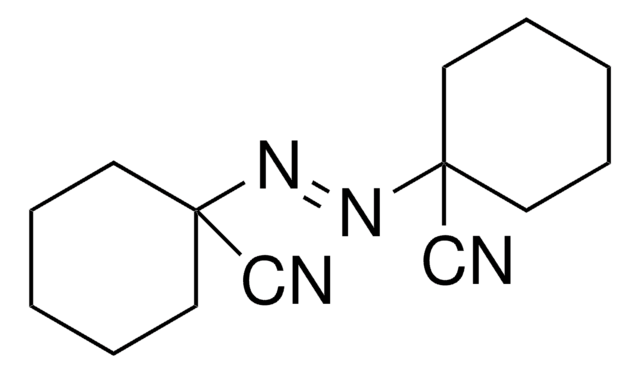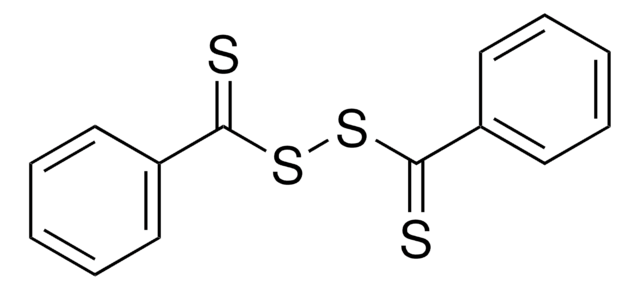11590
4,4′-Azobis(4-cyanovaleric acid)
≥98.0% (T)
Sinônimo(s):
4,4′-Azobis(4-cyanopentanoic acid), ABCVA, ACVA
About This Item
Produtos recomendados
Nível de qualidade
Ensaio
≥98.0% (T)
forma
solid
Impurezas
≤1% water
pf
118-125 °C (dec.) (lit.)
grupo funcional
azo
temperatura de armazenamento
2-8°C
cadeia de caracteres SMILES
CC(CCC(O)=O)(\N=N\C(C)(CCC(O)=O)C#N)C#N
InChI
1S/C12H16N4O4/c1-11(7-13,5-3-9(17)18)15-16-12(2,8-14)6-4-10(19)20/h3-6H2,1-2H3,(H,17,18)(H,19,20)/b16-15+
chave InChI
VFXXTYGQYWRHJP-FOCLMDBBSA-N
Procurando produtos similares? Visita Guia de comparação de produtos
Categorias relacionadas
Aplicação
Ações bioquímicas/fisiológicas
Palavra indicadora
Danger
Frases de perigo
Declarações de precaução
Classificações de perigo
Self-react. D
Código de classe de armazenamento
5.2 - Organic peroxides and self-reacting hazardous materials
Classe de risco de água (WGK)
WGK 2
Ponto de fulgor (°F)
Not applicable
Ponto de fulgor (°C)
Not applicable
Equipamento de proteção individual
Eyeshields, Gloves, type P3 (EN 143) respirator cartridges
Escolha uma das versões mais recentes:
Já possui este produto?
Encontre a documentação dos produtos que você adquiriu recentemente na biblioteca de documentos.
Artigos
An article regarding common FAQs for initiators and stabilizers.
We presents an article about a micro review of reversible addition/fragmentation chain transfer (RAFT) polymerization. RAFT (Reversible Addition/Fragmentation Chain Transfer) polymerization is a reversible deactivation radical polymerization (RDRP) and one of the more versatile methods for providing living characteristics to radical polymerization.
Applying ARGET ATRP to the Growth of Polymer Brush Thin Films by Surface-initiated Polymerization
We presents an article about Copper(I)-mediated Living Radical Polymerization in the Presence of Pyridylmethanimine Ligands, and the emergence of living radical polymerization mediated by transition metal catalysts in 1995, which was a seminal piece of work in the field of synthetic polymer chemistry.
Protocolos
We presents an article featuring procedures that describe polymerization of methyl methacrylate and vinyl acetate homopolymers and a block copolymer as performed by researchers at CSIRO.
Sigma-Aldrich presents an article about RAFT, or Reversible Addition/Fragmentation Chain Transfer, which is a form of living radical polymerization.
Sigma-Aldrich presents an article about the typical procedures for polymerizing via ATRP, which demonstrates that in the following two procedures describe two ATRP polymerization reactions as performed by Prof. Dave Hadddleton′s research group at the University of Warwick.
Nossa equipe de cientistas tem experiência em todas as áreas de pesquisa, incluindo Life Sciences, ciência de materiais, síntese química, cromatografia, química analítica e muitas outras.
Entre em contato com a assistência técnica


![4-Cyano-4-[(dodecylsulfanylthiocarbonyl)sulfanyl]pentanoic acid 97% (HPLC)](/deepweb/assets/sigmaaldrich/product/structures/204/925/30ae6ca0-5b0b-4963-a061-7e5e3d1a85af/640/30ae6ca0-5b0b-4963-a061-7e5e3d1a85af.png)



![2-[[(2-Carboxyethyl)sulfanylthiocarbonyl]-sulfanyl]propanoic acid](/deepweb/assets/sigmaaldrich/product/structures/427/606/b02310e2-102e-4324-b09d-e4c0de4fab2c/640/b02310e2-102e-4324-b09d-e4c0de4fab2c.png)


